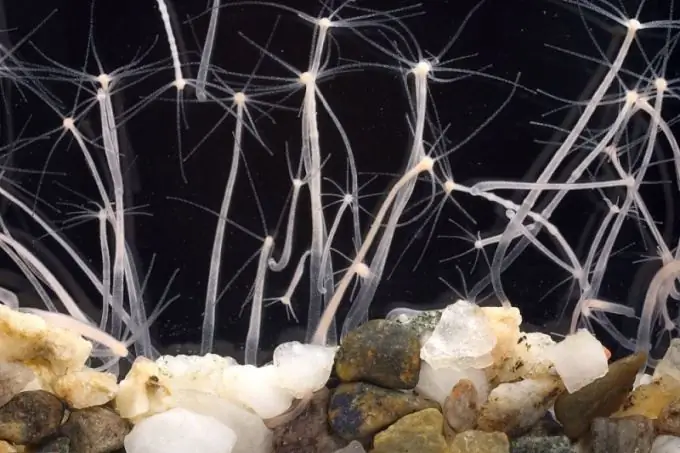- Author Delia Mathews [email protected].
- Public 2023-12-16 00:05.
- Last modified 2025-01-22 15:45.
Hydra lives in lakes, rivers and other bodies of water with clear, clear water. This small, translucent polyp attaches to the stems of underwater plants and is sedentary. However, the hydra is capable of movement.

Instructions
Step 1
Freshwater polyp hydra are classified as coelenterates. It has a regular, almost cylindrical body and numerous tentacles. At one end of the body there is a mouth, surrounded by several thin long tentacles, and the other is elongated in the form of a stalk. The sole of the hydra is attached to underwater plants and objects. Its entire body is up to 7 mm long, but the tentacles can be extended by several centimeters.
Step 2
The body of the coelenterate has radial symmetry: if an imaginary axis is drawn along it, the tentacles of the hydra will diverge from the axis in all directions. Hanging from the stem, the hydra constantly sways and moves its ray-like tentacles, trapping prey that can appear from all directions. For animals leading an attached, sedentary lifestyle, it is, as a rule, precisely ray symmetry that is characteristic.
Step 3
The body of a hydra looks like a two-layer sac, inside which there is an intestinal cavity - the only cavity of the animal's body. The outer layer of cells is called the ectoderm, the inner layer is called the endoderm.
Step 4
In the ectoderm, the hydra has the most skin-muscle cells. They form the covering of the animal and participate in movements. At the base of each musculocutaneous cell lies a contractile muscle fiber, and when the fibers of all cells contract, the body of the coelenterate contracts. When the fibers on one side of the body contract, the hydra will bend in that direction. So she can move from place to place, bending with her body and treading with tentacles, then with the sole. To some extent, this is similar to how a flexible tumbling plunger "runs away".
Step 5
There are also nerve cells in the ectoderm. They have long branches and are star-shaped. The processes of all nerve cells cover the body of the hydra, forming a nerve plexus. Some of them come into contact with skin and muscle cells.
Step 6
Hydra can sense touch, react to temperature changes, the appearance of any dissolved substances in the water, and other irritations. This excites her nerve cells and causes a reflex reaction. So, if the animal is poked with a thin needle, the body of the hydra will shrink into a lump.
Step 7
The hydra has many stinging cells, especially in the tentacles. In each nettle cell there is a stinging capsule with a coiled stinging thread, and a sensitive hair sticks out. When a fry or crustacean touches this hair, the poisonous stinging thread will immediately straighten and "shoot" at the victim. The hydra will then pull the prey to its mouth and swallow it.




